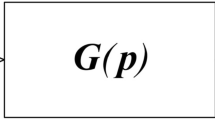Abstract
In this paper, a parameter-free optimization method for controlling the time-dependent response of frame structures is proposed. The proposing method deals with three optimization problems, including a vibration displacement minimization problem, a vibration displacement control problem, and a dynamic compliance minimization problem, which is the special case of the vibration minimization problems. These time-dependent optimum design problems are formulated as distributed-parameter optimization problems and the sensitivity functions for the shape variation to obtain the optimal shape are derived based on the material derivative method, Lagrange multiplier method, and the adjoint method. The derived sensitivity function is applied to the H1 gradient method for frames, which is a gradient method in the function space to determine the optimal shape variation. With the proposed method, the optimal shape for time-dependent response problems such as a forced vibration, a free vibration, or a transient response is obtained while minimizing the objective functional and maintaining the smoothness of a frame structure. Several numerical design examples including a continuous dynamic force or an impulse force as an input force are shown to verify and validate the effectiveness of the proposed method and the results are discussed.




















Similar content being viewed by others
References
Allahdadian S, Boroomand B (2016) Topology optimization of planar frames under seismic loads induced by actual and artificial earthquake records. Eng Struct 115:140–154
Azegami H (1994) A solution to domain optimization problems. Trans Jpn Soc Mech Eng Ser A 60(574):1479–1486. (in Japanese)
Choi KK, Kim NH (2005) Structural sensitivity analysis and optimization, vol 1. Springer, New York
Choi W, Park G (2002) Structural optimization using equivalent static loads at all time intervals. Comput Methods Appl Mech Eng 191(19):2105–2122
Kang BS, Park GJ, Arora JS (2006) A review of optimization of structures subjected to transient loads. Struct Multidiscip Optim 31(2):81–95
Katamine E, Okada N (2017) Solution to shape design problems of unsteady forced heat-convection fields. Trans JSME (in Japanese)
Kim YI, Park GJ (2010) Nonlinear dynamic response structural optimization using equivalent static loads. Comput Methods Appl Mech Eng 199(9):660–676
Kim TS, Kim JE, Kim YY (2004) Parallelized structural topology optimization for eigenvalue problems. Int J Solids Struct 41(9):2623–2641
Lee JJ, Jung UJ, Park GJ (2013) Shape optimization of the workpiece in the forging process using equivalent static loads. Finite Elem Anal Des 69:1–18
Li L, Hu Y, Wang X (2013) Design sensitivity analysis of dynamic response of nonviscously damped systems. Mech Syst Signal Process 41(1):613–638
Ma Z, Kikuchi N, Cheng HC, Hagiwara I (1995) Topological optimization technique for free vibration problems. J Appl Mech-Trans Asme–J Appl Mech 62(1):200–207
Park GJ (2011) Technical overview of the equivalent static loads method for non-linear static response structural optimization. Struct Multidiscip Optim 43(3):319–337
Shimoda M, Liu Y, Morimoto T (2014) Non-parametric free-form optimization method for frame structures. Struct Multidiscip Optim 50(1):129–146
Shimoda M, Nagano T, Morimoto T, Liu Y, Shi JX (2016) Non-parametric free-form optimal design of frame structures in natural frequency problem. Int J Mech Sci 117:334–345
Shu L, Wang MY, Fang Z, Ma Z, Wei P (2011) Level set based structural topology optimization for minimizing frequency response. J Sound Vib 330(24):5820–5834
Suksuwan A, Spence SM (2018) Performance-based multi-hazard topology optimization of wind and seismically excited structural systems. Eng Struct 172:573–588
Suzuki K, Ohtsubo H (1994) Sensitivity analysis by adjoint method and optimal design of the dynamic systems that require time integration. J Soc Naval Archit Jpn 1994:317–323
Vicente W, Picelli R, Pavanello R, Xie Y (2015) Topology optimization of frequency responses of fluid structure interaction systems. Finite Elem Anal Des 98:1–13
Xu J, Spencer BF, Lu X (2017) Performance-based optimization of nonlinear structures subject to stochastic dynamic loading. Eng Struct 134:334–345
Xu LH, Yan XT, Li ZX (2018) Development of bp-based seismic behavior optimization of rc and steel frame structures. Eng Struct 164:214–229
Yan K, Cheng GD, Wang BP (2018a) Topology optimization of damping layers in shell structures subject to impact loads for minimum residual vibration. J Sound Vib 431:226–247
Yan K, Wang BP, Cheng GD (2018b) Residual vibration reduction for translation unconstrained or partially unconstrained structures by structural optimization. Comput Struct 210:12–27
Yoon GH (2010) Structural topology optimization for frequency response problem using model reduction schemes. Comput Methods Appl Mech Eng 199(25):1744–1763
Yun KS, Youn SK (2017) Design sensitivity analysis for transient response of non-viscously damped dynamic systems. Struct Multidiscip Optim 55(6):2197–2210
Funding
A part of this research was supported by a Grants-in-Aid for Scientific Research given by JKA (Grant Number 2019M1-141).
Author information
Authors and Affiliations
Corresponding author
Ethics declarations
Conflict of interest
The authors declare that there is no conflict of interest.
Additional information
Responsible Editor: Gengdong Cheng
Replication of results
The optimization system developed consists of in-house C programs and MSC NASTRAN for FE analyses. Their executions are controlled with “Batch program” on Windows OS until the convergence. For the benchmark calculation by readers, we will provide NASTRAN model data used in this paper.
Publisher’s note
Springer Nature remains neutral with regard to jurisdictional claims in published maps and institutional affiliations.
Rights and permissions
About this article
Cite this article
Shimoda, M., Liu, Y. & Wakasa, M. Free-form optimization method for frame structures aiming at controlling time-dependent responses. Struct Multidisc Optim 63, 479–497 (2021). https://doi.org/10.1007/s00158-020-02708-y
Received:
Revised:
Accepted:
Published:
Issue Date:
DOI: https://doi.org/10.1007/s00158-020-02708-y




